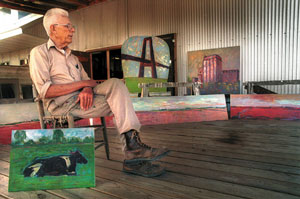THE DREAM STATE
Elemore Morgan Jr.’s colorful work captures the essence of the land he loves, like his father’s before him.
by Doug Maccash, The Times-Picayune
Art critic
Landscape painter Elemore Morgan Jr. says that as he stands at the edge of a rice field in the Louisiana heat and humidity, brushing flurries of fiery color onto oddly shaped Masonic panels, he can sense the curve of the Earth beneath him.
‘I swear, in my own little back yard I can almost feel the shape of the planet,’ Morgan says.
“This might sound kind of cosmic or mystic,” said the 75-year-old, Baton

'I swear, in my own little back yard I can almost feel the shape of the planet,' Morgan says.
Rouge-born artist, “but one of the things that excites me about the prairie, is that it’s 80 percent sky and 20 percent land. Much of what you see is sky, it”s a great dome. When you paint out here, you can feel the Earth falling off to either side. … I swear, in my own little back yard I can almost feel the shape of the planet.”
Visitors to Morgan’s tour de force, 109-piece exhibit “Art and Life in Louisiana” at the Ogden Museum of Southern Art may almost feel the Earth falling away too. Perhaps because his unframed, oval, urn and rearview mirror-shaped paintings seem to hover in place. Perhaps because his brush strokes are so energetic and airy that even the buildings, bridges and strips of land in his paintings seem weightless, not to mention the billowing cumulus clouds. Or perhaps it’s because his sometimes strange blends of orange, blue, pink, green and purple seem to crackle and rise like sparks from a bonfire. The expansive, universal feel of Morgan’s work is difficult to explain precisely. Cosmic or mystic may be the best words for it. In a recent telephone interview from his home near Lafayette, Morgan said that his characteristically buoyant color combinations come to him naturally.
“Color to me is part of a personality profile,” he said. “The color profiles we have embedded in us are what we should work with. You need to be in tune with your own frequency. … I get from nature stimuli that make me respond in a certain way. What we call local color, the (actual) colors of all the grass and trees and stuff like that. We don”t have any allegiance to that.”
Despite his lack of allegiance to grass green, sky blue and dirt brown, Morgan has an amazing knack for transmitting what’s real and true about the wetlands. The horizon line may be a startling Windex-blue stripe. Orange Popsicle-colored bolts may ripple through the shadows along the tree line. Lipstick red smears may outline the roadway. Everywhere there may be colors too strident for Vermilion or Acadia Parishes, yet when you look at a Morgan landscape, you can almost feel the Louisiana summer sweat beading on your forehead and hear the cicadas in the distance.
Morgan’s bayou-fauvist style is both studied and passionate, contemplative and immediate, warmly traditional and coolly contemporary. Maybe that”s why he”s one of the most popular and respected Dream State artists. His 30-year professorship at University of Southwestern Louisiana (from 1968 to 1998) made him one of the most influential.
“Art and Life in Louisiana” is a 60-year retrospective. Morgan fans will be able to retrace the development of his style, from some of his recent Crescent City riverscapes, back to his formative period in the 1970s and 1980s when his signature post-impressionist technique came into focus. Then back to his days following the Korean War when he was painting the English and European countryside while studying on a GI Bill at Oxford University. He was the first American to receive an arts diploma from the Ruskin School of Fine Art at Oxford. Then further back to the figure drawings and cubist experiments from his college days at LSU, where he studied with the legendary Caroline Durieux. There are even boyhood sketches from Baton Rouge High.
And, in a way, fans will even be able to go further back when they visit the accompanying exhibit of 48 photographs by Elemore Morgan Sr. (1903-1966), who, decades earlier, artistically explored the same South Louisiana environment as his son. It”s interesting to note that though Morgan senior focused on the architecture and occupants of South Louisiana, the fishers, farmers, musicians and just plain folk, his son”s landscapes are almost always vacant.
“I don’t necessarily want to depopulate my landscapes,” Morgan said, “but I guess I’m responding to the austerity of the landscape. .. If people got into them it would be fine with me. But I”m engrossed with my own relationship with this environment.”
Despite the dramatic differences in their styles, Morgan, an only child, is quick to acknowledge his father’s importance to his artistic worldview.
“I really revered my father,” he said, “and as I get older, I realize how he did influence me in many ways. We both love Louisiana, it”s a source for both of us. From him, my grandmother and other members of our family, we all have a sense of history. We love the whole history, this whole ambiance of South Louisiana.”
Morgan plans to donate his father’s photographs to the Ogden after the exhibit. A catalog of the father-son show is in the works and may be available by the July 31 closing of the show.
